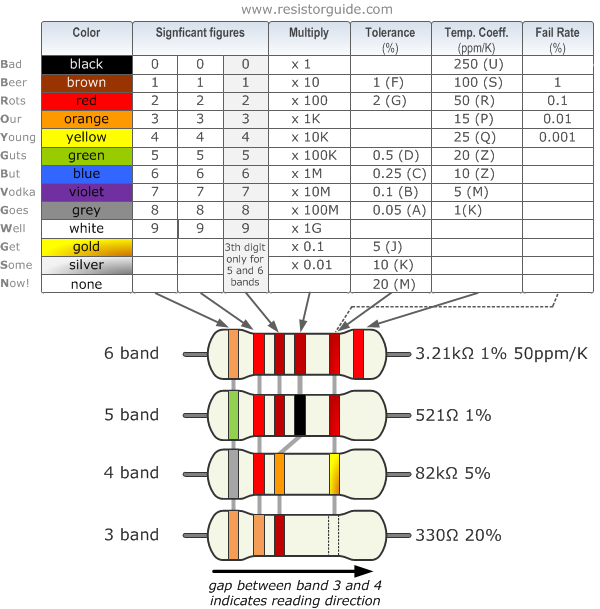

1 ohm resistor color code code#
In the 1920s, the RMA resistor color code was developed by the Radio Manufacturers Association (RMA) as a fixed resistor coloring code marking. 1945–1950īefore industry standards were established, each manufacturer used their own unique system for color coding or marking their components.
1 ohm resistor color code how to#
Newbie? Click here to learn how to read resistor values.RMA resistor color code guide, ca. It is faster and less prone to error to use online tools. While one should understand the calculations behind RMS Voltage, Stepper motors, and resistance in parallel, they should not frequently perform these calculations themselves. If one is working with electronics, they should make as much use of online calculating tools as possible. While the resistance of a zero Ohm resistor is not literally zero, it is very low, only about 0.003 Ohms. A zero-ohm resistor can be used in these circumstances. When building circuit boards, it is sometimes useful to link two points together with a resistor. If a resistor has a single black band on it, it offers no or almost no resistance. However, there are still some cases in electronics when one needs a resistor that is capable of blocking only a very weak current.ī) Single Black Band or Zero-Ohm resistor Most currents can easily pass through these resistors. With a silver band, the multiplier is 0.1, and with a gold band, it is 0.01. Gold and silver multipliers represent a very low level of resistance. If a resistor has five bands, then the fourth or second last band is the multiplier. Overview:Ī) 5 band resistor with a 4th band of gold or silver This gives a maximum resistance of 17,259. The final band is silver, so the tolerance is +/- 10 percent. This gives an overall resistance of 15690 Ohms. It is yellow, so the multiplier is x10,000. The fifth band must be the multiplier because it is the second last. If the first four bands on a six-band resistor were brown, green, blue, and white, this would give a value of 1.569. The last band is always the tolerance, and the second last band is always the multiplier. With a six-band resistor, the bands represent the following:ġ) First significant digit 2) Second significant digit 3) Third significant digit 4) Fourth significant digit 4) Multiplier 5) Tolerance These give more accuracy about how high the resistance is on their color codes. Some resistors have more than four bands. For tolerance, the color codes are as follows: The last band on any resistor determines the tolerance of the resistor. This gives a total value of 9.5*1000 or 9500 ohms worth of resistance. The third band in a four-band resistor is a multiplier, with a value of x1000 if the third band is orange. X1 Black x10 Brown x100 Red x1000 Orange x10000 Yellow x100000 Green x1000000 Blue x10000000 Violet x100000000 Grey x1000000000 Whiteįor example, a four-band resistor might have a color code of white (9) and green (5) for its first two bands.

The values of each multiplier are as follows: Since the difference between one resistor and another is immense (from one-hundredth of an Ohm to 10 billion Ohms), a multiplier is used. In the four band resistor, there are only two significant figures worth of accuracy. The numbers are color-coded in the following way:Ġ – Black 1 – Brown 2 – Red 3 – Orange 4 – Yellow 5 – Green 6 – Blue 7 – Violet 8 – Grey 9 – White This is the first significant digit of the resistors total resistance. If there are four bands, the four bands have the following meanings: Resistors can have either four bands, five bands, or six bands, depending on how precisely the resistance is being measured. By inputting the colors of the first, second, third, and fourth bands, one ends up with the resistance, tolerance, minimum, and maximum. If one has not memorized the colored codes well enough to be able to tell the properties of the resistor at a glance, an online tool can help them. This allows anyone working with electronics to determine the properties of a resistor just by looking at the colored bands that the resistor has. – What is a resistor color code calculator for?Īll resistors are color-coded.


 0 kommentar(er)
0 kommentar(er)
